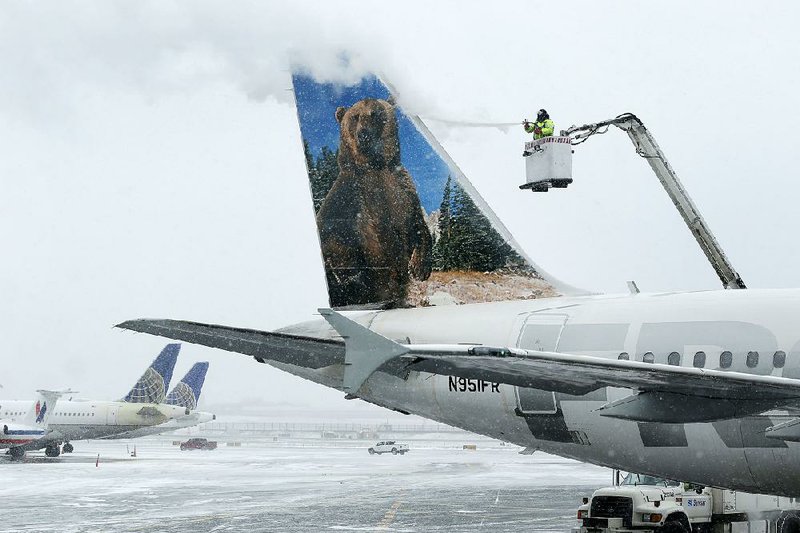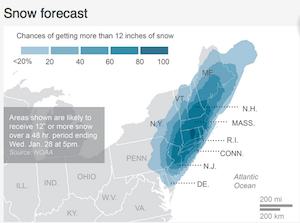NEW YORK -- As more than 35 million residents in the Northeast prepared for a powerful blizzard bearing down on the region, bringing with it near-hurricane-force winds along the coast and as much as 3 feet of snow, officials from New Jersey to Maine and north into Canada urged people to get off the roads and stay indoors.
Snow was blowing sideways with ever-increasing intensity in New York City by midafternoon as flurries began in Boston. As the snow got heavier, much of the region rushed to shut down.
More than 7,700 flights were grounded, with another 1,700 delayed. Public transportation was suspended or curtailed. Travel bans were put in place in several states in the path of the storm.
Gov. Andrew Cuomo of New York announced Monday that all subway and bus service in New York City was to stop at 11 p.m. Monday.
"Mother Nature has decided once again to come visit us in an extreme way," he said. "This is going to be a blizzard. It is a serious blizzard. It should not be taken lightly."
Schools and businesses let out early. Government offices closed. Shoppers stocking up on food jammed supermarkets and elbowed one another for what was left. Broadway stages went dark.
Many buses and trains were packed Monday afternoon as officials urged people to leave work early, before heavy snow and high winds made travel treacherous or impossible.
"This will most likely be one of the largest blizzards in the history of New York City," Mayor Bill de Blasio said Monday.
Up to now, this has been a largely snow-free winter in the urban Northeast. But this storm threatened to make up the difference in a single blow.
Joe Pollina, a meteorologist for the National Weather Service, said Monday night that the storm remained on track to deliver as much as 3 feet of snow to parts of New York City.
Most of the city, he said, could expect about 2 feet of snow, but in the southern parts of Queens and Brooklyn, he said, totals could reach 36 inches.
Boston was expected to get 2 to 3 feet of snow and Philadelphia more than a foot.
The record snowfall in New York City came in 2006, when 26.9 inches of snow was measured in Central Park.
De Blasio took the unusual step of ordering all drivers off the streets by 11 p.m. Monday, a ban that he said covered "anything that has to do with leisure or convenience," including, to the chagrin of many housebound New Yorkers, food delivery.
De Blasio said the decision to order all drivers off the roads was necessary to ensure that sanitation workers can clear streets and emergency workers can get where they need to go. He said the order extended to those making food deliveries on bicycles.
In all, New York has deployed some 1,800 plows to clear more than 6,000 miles of roadways, and the mayor asked that residents act responsibly and stay inside.
Subway service was to continue but on a limited basis after 7 p.m. Monday, officials said. Service on the Long Island Rail Road and Metro-North was to be suspended at 11 p.m. New Jersey Transit was to stop running trains at 10 p.m. and officials said that they did not expect service to be restored on commuter trains until Thursday.
On Wall Street, however, the New York Stock Exchange stayed open and said it would operate normally today as well.
The call to completely clear the city's streets was a reflection of how seriously public officials were taking the threat of the storm, which was expected to affect a 250-mile stretch of the Northeast.
"People have to make smart decisions from this point on," de Blasio said. "It is not business as usual."
Nicole Coelho, 29, a nanny from Lyndhurst, N.J., was preparing to pick up her charges early from school and stocking up on macaroni and cheese, frozen pizzas, and milk at a supermarket.
"I'm going to make sure to charge up my cellphone, and I have a good book I haven't gotten around to reading yet," she said.
Across the region, governors declared states of emergency, deployed National Guard units, and readied fleets of snowplows and salt trucks.
Coastal areas, including eastern Long Island, Cape Cod and other parts of New England, were expected to be battered by winds that could blow nearly as strong as a hurricane, leading to possible flooding and widespread power failures that might last for days. Utility companies across the region put additional crews on standby.
Officials in New Jersey shore towns warned people to move their cars off the streets and away from the water.
The wind-driven snow will create whiteout conditions, and gusts, as much as 60 miles per hour in places, can snap off tree limbs, down power lines and drive snow into heavy drifts.
"Obviously, with the winds, snow drifts of 6 to 8 feet high are possible," said Tom Kines, a meteorologist with AccuWeather Inc. in State College, Pa. "You have to worry about roofs, too; there will be a lot of weight from the snow on roofs."
The storm will have a greater effect because of its slow speed, Kines said. When it gets even with New York City, it should slow down, and that means heavy snow could fall for as long as 12 hours.
The public seemed to heed the warnings, crowding the aisles of grocery stores and stocking up on supplies at home goods stores.
"We're used to these big snowstorms in New England, but 2 to 3 feet all at once and 50 to 60 mph winds? That's a different story," said Ben Shickel, 24, who went grocery shopping in Chestnut Hill, Mass., and found shelves had been cleaned out.
Given that cars being stranded on roads and highways has proved to be a problem during recent storms, state leaders all had a common message: Get off the roads as soon as possible.
"This is a top-five historic storm, and we should treat it as such," said Gov. Charlie Baker of Massachusetts. "This is clearly going to be a really big deal."
It is also the first storm Baker has faced since he was sworn in this month and, like other politicians, he is keenly aware that he will be judged on the state's response.
Baker ordered a statewide travel ban in effect as of midnight Monday, and the Massachusetts Bay Transportation Authority, which operates the Boston subway system and commuter rail lines, will shut down service at midnight Monday and will remain closed today.
In Boston, Mayor Martin Walsh also ordered drivers off the street Monday evening and said residents would be notified via loudspeaker that a parking ban will go into effect at 6 p.m.
"You should not be driving in the city of Boston," the mayor said. "All residents, once you park your car, leave your car there and do not leave your house."
In southern New England, officials prepared for as much as 3 feet of snow and high winds that could cause widespread power failures.
"This is not going to be a run-of-the-mill nor'easter," said Alan Dunham, a meteorologist with the National Weather Service's forecast office in Taunton, Mass. "This storm has the potential to be a historic storm."
Dunham said the storm would intensify rapidly, and in Cape Cod, the winds could exceed 75 mph.
He said that a phenomenon called thundersnow -- essentially, a thunderstorm with snow instead of rain that he said had the potential to put down a "tremendous" amount of snow -- was possible.
Connecticut Gov. Dannel Malloy urged people to have at least three days of food for themselves and their pets on hand before the storm starts and declared a statewide travel ban starting at 9 p.m.
Connecticut officials expect more than 100,000 homes to lose power. Malloy said the state National Guard and U.S. Coast Guard are in place to help manage the effects of the storm, and the Connecticut Department of Transportation has its entire fleet of more than 600 crews active.
Meanwhile, the Washington area was expecting only a couple of inches of snow. But the House postponed votes scheduled for Monday night because lawmakers were having difficulty flying back to the nation's capital after the weekend.
And in Rhode Island, Gov. Gina Raimondo, facing the first major snowstorm of her first term, issued a travel ban starting at midnight Monday, though she urged drivers to get off the roads by 8 p.m.
"We believe this storm is so severe that it poses an imminent threat to the safety of our citizens," said Raimondo at a news conference, in which she urged Rhode Islanders to take the same preparations she herself is taking.
"We've got our bread, we've got our milk, we've got our water, we've got my mother coming over today," Raimondo said, "and I'd ask every Rhode Islander to do that."
Information for this article was contributed by Marc Santora, Jess Bidgood, Matt Flegenheimer, Michael M. Grynbaum and Katharine Q. Seelye of The New York Times; by Meghan Barr, Dave Collins, Pat Eaton-Robb, David Porter, Jim Fitzgerald, Bruce Shipkowski, Deepti Hajela, Jonathan Lemire, Verena Dobnik, Albert Stumm, Marcy Gordon, Darlene Superville and David Koenig of The Associated Press; and by Brian K. Sullivan, Kelly Bit, Katherine Chiglinsky, Christine Buurma, Kelly Gilblom, Serena Saitto, Antonia Massa, Lars Paulsson, Naomi Christie, Annie Linskey and Alexandra Mondalek of Bloomberg News.
A Section on 01/27/2015


